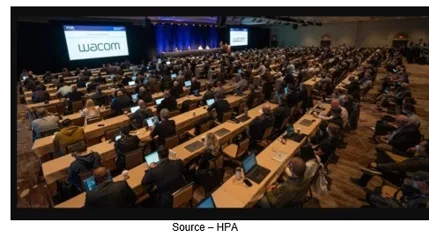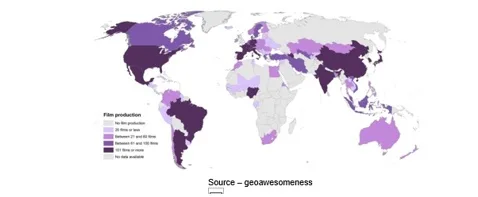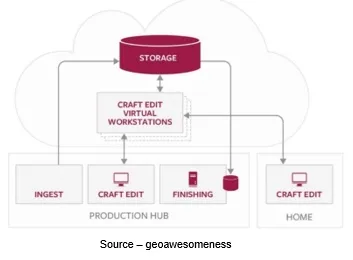HPA Shows Virtual Production is Real – Easy, Economic
 We figured this year’s HPA (Hollywood Professional Association) Tech Retreat would be “a little” slow after two years of people going to the set, getting sent home, starting/stopping projects and work.
We figured this year’s HPA (Hollywood Professional Association) Tech Retreat would be “a little” slow after two years of people going to the set, getting sent home, starting/stopping projects and work.
Personally, our biggest goal that was set for this year has been to get out and reconnect with people.
The only event we had that served as somewhat of a guide was CES in Las Vegas – which was great, but the Palm Springs event still had a question mark.
Surprise!

It has been a long time since you’ve seen executives so pleased to find out who missed what, who’s been promoted, and what has been going on outside of their confines over the last two years since the last face-to-face event.
The industry tech execs (studios, content owners, producers/directors, crew, distributors, and production tool/product developers) proved they hadn’t been sitting on their hands or simply filling the hours with Zoom calls.
The industry has made significant progress over the last two years versus the two decades before from the C.B. DeMille era to the George Lucas era.
Improvements and advancements have emerged that make both forms virtual and on-set of content creation/production better, faster and maybe just a little easier for the entire production team.
More importantly, the executives in attendance openly wanted to share their insights and information and learn what others had done in the past couple of years to make content production faster, easier, better, more economic.

In addition to a packed agenda of in-depth presentations and panel sessions, conference management conducted a daylong Supersession to demonstrate, discuss and work with the latest virtual production (VP) technologies.
From the moments the doors opened until they closed in the evening, attendees got to experience VP from concept through post in a wide range of production environments including multiple LED walls, cameras and the latest versions of game engines.

In fact, attendees were able to see a number of different LED video wall technologies up close during the Supersession and the following exhibitor sessions.
LED video walls aren’t exactly new because Disney and ILM showed us their potential with their initial production of The Mandalorian.

Since then, other manufacturers have developed LED video wall technology solutions so it has become more widely available for production operations and new studios.
Thanks to newer, more lower cost wall technologies, new studio outlets and production stage owners have been launching virtual production stages equipped with the LED-screen backdrop, quickly replacing older green screens and enabling technicians to create a virtual set in real time.
One of the first things directors and project owners found is that the new technology enabled them to minimize the expenses and challenges of shooting in a variety of locations because they could be duplicated with the virtual screen technology.
For example, the only “remote” shoots The Mandalorian crew had to conduct were the use of drone cameras to capture details of Arizona’s Monument Valley.

Because of the ability to reduce travel time/costs and deliver a better project in a shorter amount of time, studio owners around the globe have been building new, better facilities.
New video production facilities have been cropping up in Montreal, Toronto, Atlanta, New York City, London, Berlin, Kenya, Melbourne, Wellington, Singapore and other major cities around the globe.
Even before the facilities are completed, organizations like Netflix, Disney, Warner Bros, Universal, BBC and other content producers are signing long-term leases because shooting around the globe is both expensive and increasingly uncertain.
“Multiple location shoots certainly aren’t completely gone,” said Allan McLennan, CEP/Media, Head of M&E Americas, Atos; “but new technologies can help reduce your key budgets – time/money – and provide virtual locations to you rather than traveling and incurring increased budgets.
“In addition, with LED walled stages, directors can manipulate the projects surroundings and backgrounds and then decide which creative solution they want,” he added.
But the full scope of virtual production is more than the wall.
Perhaps the real key to the future of VP is the use of game engines like Epic Games Unreal Engine and Unity.
The game engines are an integral part of every VP facility, especially the London-based The Foundery which has become the go-to production tool for all of the leading studios and post-production houses.
To help us understand the power of the technology even more, McLennan pointed to the YouTube segment of Epic’s video series The Pulse which explains Epic’s view of tomorrow’s real-time TV/filmmaking and virtual production.
Executives at HPA’s Supersession did an excellent job of giving attendees overviews of the potential but you’ll probably want to spend more time at https://tinyurl.com/y2nysc4z and other segments of The Pulse.
Think about it … filmmakers creating, shooting in virtual sets in real-time!
Tomorrow’s lookin’ good.
While we really hate to admit it, the past two years of steady content flow proved that VP also includes a strong dose of cloud production and storage.
Almost every organization that supported this year’s HPA had a cloud-based solution including Adobe, AWS, Arch, Ateliere, Atos, BeBop, Convergent, Deluxe Media, IBM, Azure, Rackspace, Dolby Labs, EditShare, Eluvio, Equinix, FPT Software, ICVR, Iyuno-SDI Group, Microsoft, NAGRA, Atos, Perforce Software, Shift, Signiant, Sohonet, Sony, Teradici, Testronic, Veritone, Vubiquity, Wasabi and others.
The cameras, lenses, transmission, monitoring, LUTs, shading/live color timing and other solutions were an integral part of the Supersessions.
In other words, the cloud has become indispensable to content creation teams.

One of the first benefits producers found is that they weren’t limited to editors, special effects, audio and other creatives who were local. Instead, they could almost instantly work with the best talent on the planet.
McLennan emphasized, “Producers, executives and team members are all finding they can be just as responsive, productive and responsible than if they’re in the same office or even the same time zone. They can check, modify, adjust, readjust and work in real-time more efficiently and in many ways more effectively than before.”
The major concern everyone in the content development, production and distribution field has been security, accessibility and transmission bandwidth because they accumulate a lot of valuable content they may need later.
Original and insurance files are still secured on on-prem physical storage, but creative teams have been able to finish projects by moving content directly from the camera to the cloud and almost instantly make it available to authorized specialists to work on at their workstations or remotely in the cloud.
Better cameras and sensors provide very high in-camera data rates and allow very low on-set acquisition. Reusable high-speed media made it fast and easy to simply keep cameras rolling to capture everything … just in case.
All of that content from beginning to end is used by about everyone on the production team who need to ensure content quality and that the finished work meets everyone’s creative standards.
It doesn’t sound too tough until you realize that digital content builds up quickly when you’re shooting in 4K or 8K UHD (ultra-high def), HFR (high frame rate), WCG (wide color gamut), HDR (high-dynamic-range) and just about every acronym you can think of.
It’s a lot of data and it all has to be saved/preserved, just in case including:
- Original Media exactly as shot
- Protection Clone (never to be touched)
- Worker Copy (files renamed, organized)
- Protection Copy of Worker
- Studio copy of Worker
- 3rd Clone of Worker for safety
- Output of project
- Clone and 2nd Protection
- Archive
That’s a big bunch of data!
“Storing and moving content to and through the cloud has been a major initiative for the industry in recent years,” said McLennan. “The global lockdown placed extra pressure on studios and production teams to make it an integral part of their project’s workflow.
“There are still some of issues to be worked out,” he noted, “but we’ve been able to keep the work flowing. The combination of video conferencing and sharing of screens to make more informed decisions on ‘what if’ and alternative approaches has resulted in more efficient, effective and secure solution than the industry’s past physical storage/exchange approach.”
The biggest challenge production teams deal with is moving TBs of creative data around is transmission bandwidth.
While you may have heard that now that we have 5G connectivity everywhere, sending big data files across the country or halfway around the globe is fast, simple and reliable because we now have the bandwidth.
It’s not true and will be years before it will be everywhere and. reliable!
For this reason, most post work is done with proxy files (low-res copies of the originals) which can be easier to work with on your on-prem system as well as in the cloud.
Despite the periodic hiccups, remote workflow is here to stay. The trend started well before the pandemic.
The pandemic simply accelerated the trend and enabled the industry to use it in all aspects
of the film/show life cycle …even work that was being done in the same city has shifted to remote. The industry has always been decentralized and was already moving to fully digital production, so this was treated as just another step in providing a newer, better and faster way to efficiently deliver quality content.

The 2022 HPA Tech Retreat Supersession just added more credibility to the fact that virtual production will be used by everyone in the industry regardless of the budget … very soon.
And yes, NAB is just around the corner and we’re looking forward to it!
# # #
Andy Marken – [email protected] – is an author of more than 700 articles on management, marketing, communications, industry trends in media & entertainment, consumer electronics, software and applications. Internationally recognized marketing/communications consultant with a broad range of technical and industry expertise especially in storage, storage management and film/video production fields. Extended range of relationships with business, industry trade press, online media and industry analysts/consultants.